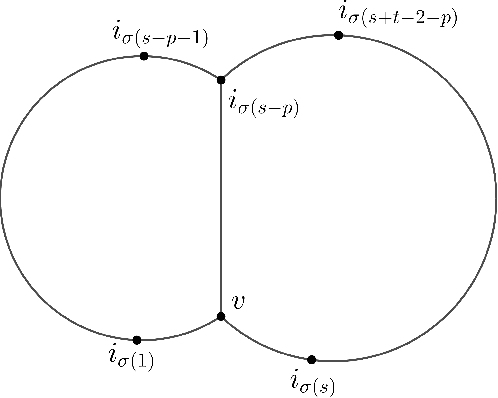Simon Briend
Leaf Stripping on Uniform Attachment Trees
Oct 09, 2024Abstract:In this note we analyze the performance of a simple root-finding algorithm in uniform attachment trees. The leaf-stripping algorithm recursively removes all leaves of the tree for a carefully chosen number of rounds. We show that, with probability $1 - \epsilon$, the set of remaining vertices contains the root and has a size only depending on $\epsilon$ but not on the size of the tree.
Estimating the history of a random recursive tree
Mar 14, 2024Abstract:This paper studies the problem of estimating the order of arrival of the vertices in a random recursive tree. Specifically, we study two fundamental models: the uniform attachment model and the linear preferential attachment model. We propose an order estimator based on the Jordan centrality measure and define a family of risk measures to quantify the quality of the ordering procedure. Moreover, we establish a minimax lower bound for this problem, and prove that the proposed estimator is nearly optimal. Finally, we numerically demonstrate that the proposed estimator outperforms degree-based and spectral ordering procedures.
On the quality of randomized approximations of Tukey's depth
Sep 11, 2023Abstract:Tukey's depth (or halfspace depth) is a widely used measure of centrality for multivariate data. However, exact computation of Tukey's depth is known to be a hard problem in high dimensions. As a remedy, randomized approximations of Tukey's depth have been proposed. In this paper we explore when such randomized algorithms return a good approximation of Tukey's depth. We study the case when the data are sampled from a log-concave isotropic distribution. We prove that, if one requires that the algorithm runs in polynomial time in the dimension, the randomized algorithm correctly approximates the maximal depth $1/2$ and depths close to zero. On the other hand, for any point of intermediate depth, any good approximation requires exponential complexity.
Broadcasting in random recursive dags
Jun 02, 2023



Abstract:A uniform $k$-{\sc dag} generalizes the uniform random recursive tree by picking $k$ parents uniformly at random from the existing nodes. It starts with $k$ ''roots''. Each of the $k$ roots is assigned a bit. These bits are propagated by a noisy channel. The parents' bits are flipped with probability $p$, and a majority vote is taken. When all nodes have received their bits, the $k$-{\sc dag} is shown without identifying the roots. The goal is to estimate the majority bit among the roots. We identify the threshold for $p$ as a function of $k$ below which the majority rule among all nodes yields an error $c+o(1)$ with $c<1/2$. Above the threshold the majority rule errs with probability $1/2+o(1)$.
Archaeology of random recursive dags and Cooper-Frieze random networks
Jul 29, 2022

Abstract:We study the problem of finding the root vertex in large growing networks. We prove that it is possible to construct confidence sets of size independent of the number of vertices in the network that contain the root vertex with high probability in various models of random networks. The models include uniform random recursive dags and uniform Cooper-Frieze random graphs.
 Add to Chrome
Add to Chrome Add to Firefox
Add to Firefox Add to Edge
Add to Edge